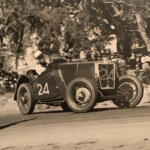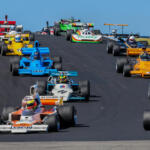GIOVANNI BRACCO AND THE LANCIA B20
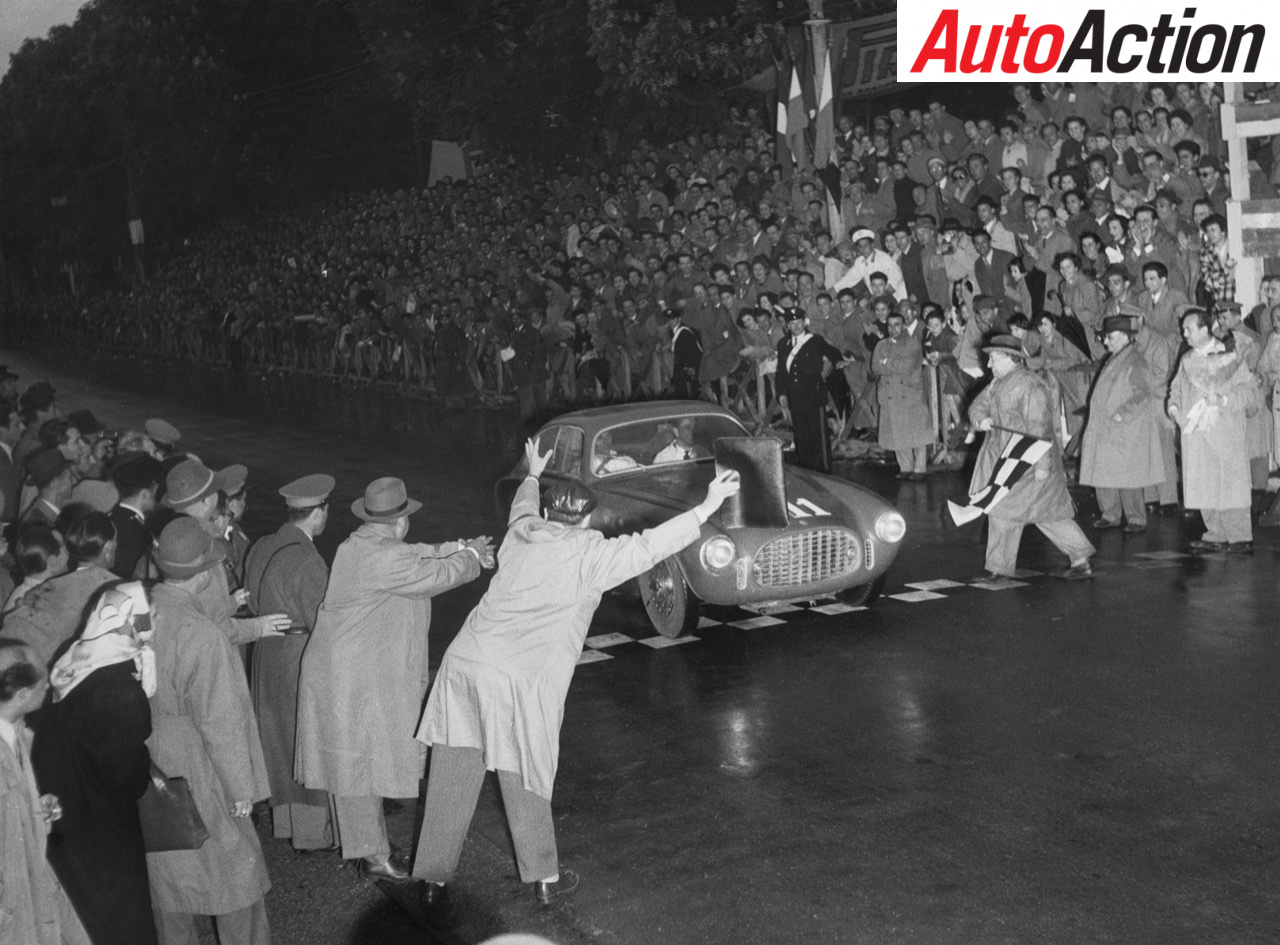
This article, written by 1970 Australian Rally Champion, Bob Watson, was first published as part of Auto Action’s ‘Great Drives’ series on June 18, 2020, here it is in slightly truncated form.
It is remarkable that Italy is the home of many famous Formula 1 makes including the most successful of all, Ferrari. And yet, it has produced just two World Driver’s Champions thus far, inaugural winner Giuseppe ‘Nino’ Farina in 1950, and two-time victor Alberto Ascari in 1952 and 1953.
Since then, nothing! That’s a long time between Spumante sprays.
However, despite the lack of success the Italians continue to be fanatical about their motor sport. Classic events such as the Targa Florio and the Mille Miglia, the Italian Grand Prix, many regional events including Rome Coppa D’Oro (Gold Cup) and many city-to-city races.
The early heroes of the day for the parochial Italians were the immortal Tazio Nuvolari, Achille Varzi, Carlo Felice Trossi, Luigi Fagioli, Piero Taruffi and Luigi Villorese, all regularly risking their lives for the glory of Italy in an array of machinery.
They drove the best of the best from Ferrari, Maserati, Alfa Romeo and Lancia, backed up by smaller manufacturers like Stanguellini and Bandini, all battling the might of the Silver Arrows of Mercedes and Porsche, and Jaguar British Racing Green machines to name but a few.
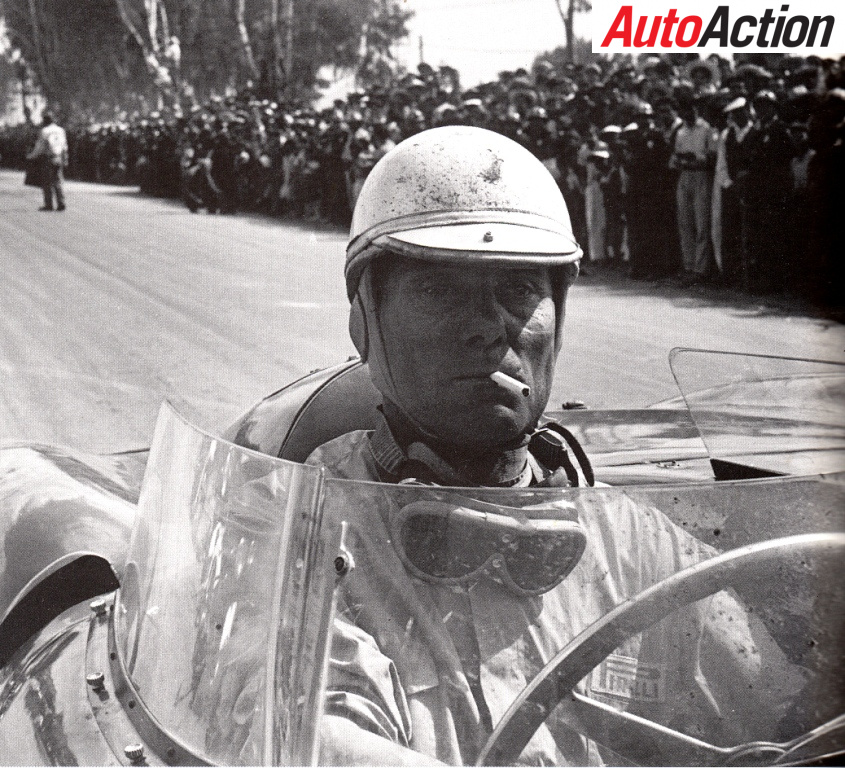
Bracco with a nerve settling fag before the off, 1953 Carrera Panamericana, Lancia D23, DNF.
One Italian driver proved particularly spectacular and successful during this period, his name was Giovanni Bracco.
Born in 1908 in the town of Biella, situated near Turin, Bracco earned his stripes well before the first world title was run. He often linked up with another young Biellese driver, Umberto Maglioli, who became a regular co-driver.
In 1947, Bracco finished ninth in the Mille Miglia driving a Fiat 1100S Berlinetta, however in September that year Bracco was competing in Modena when he lost control, with dire consequences. Due to a rival’s error, Bracco lost control of his Delage and crashed into the crowd, killing five spectators and injuring several others. This incident haunted him for the rest of his career and in the short term forced him out of racing until 1948.
On return, Bracco won the two-litre class of the Italian Grand Prix driving a Maserati A6GCS. With memories still fresh in his mind from the incident at Modena, he stopped after two laps at Pescara due to the packed stands of spectators surrounding the circuit.
Another break ensued for Bracco as he fought his mental demons.
Moving into a coupe rather than an open-wheeler appeared to ease his mind. He won his class on the way to fourth overall in the 1950 Mille Miglia alongside Magioli, driving a Ferrari 166 M.M Barchetta Touring.
A move to Lancia the following year delivered many class wins including at Le Mans with Count Johnny Lurani, and a remarkable second place outright at the Mille Miglia partnering Magioli again driving Lancia’s Aurelia B20 two-litre. In fact, the entry that beat it to the victory was the four-litre Ferrari 340 America of Gigi Villoresi.

Bracco/Rolfo Ferrari 250S Vignale, ’52 Mille Miglia
Thanks to his magnificent display the previous year, Bracco was given a three-litre Ferrari 250S Berlinetta Vignale for the ’52 Mille Miglia (opening photograph). However, he and navigator Adolpho Rolfo were not considered an official member of the Ferrari team and therefore didn’t enjoy works support. Due to his financial position, his budget didn’t even stretch to spare tyres!
Despite Taruffi or Caracciola being favoured to win Bracco was second at Siena, 12 minutes behind Kling’s Mercedes 300SL. While officials stamped his road card in Florence, Bracco asked for a flask of Cognac. Suitably fortified, he drove magnificently through the challenging, fog-bound Futa and Raticosa passes. At Bologna he led by a minute from Kling, then followed an inspired drive through the treacherous Apennines.
Only then, with the Ferrari works drivers having retired, did Enzo Ferrari order any help for Bracco, whose car badly needed tyres allowing him to hold his advantage over Kling until the end of the event, winning by four minutes. It was a brave victory in extremely treacherous conditions and as the last surviving entry from Maranello; he put to rest the demons of his accident some years before.
Bracco’s next assignment was the Carrera Panamerica in 1952 where joined Ascari in a pair of 12-cylinder ‘Mexicana Model’ Ferraris. Leading into the event, the Ferrari duo were the favourites, however Ascari’s example failed to complete the opening stage, leaving the nimble French Gordini of Jean Behra driving solo as the leader.
The Gordini handled the treacherous mountain roads best and won the first stage to Oaxaca ahead of Bracco and Kling in a Mercedes 300SLR third. On the second day Behra was the first away on the stage to Puebla, however he crashed the Gordini and Bracco now had a lead of one minute over the Germans. Bracco fought hard against the Mercedes, at the last but one stage on the fourth day, he led by almost four minutes. Then the Ferrari’s driveline failed and Bracco watched his rivals pass him, first Kling, then Lang, followed by the American John Fitch all driving Mercedes. A certain victory slipped through his fingers.
Bracco raced a Maserati 200S in 1955, but after a series of crashes and compounding health problems, he retired. He drove his personal Ferraris for a few more seasons before passing away in 1968.
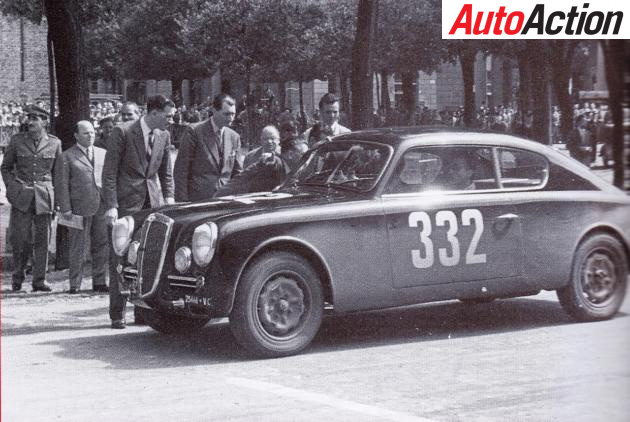
Bracco and Lurani, Lancia Aurelia B20 during the ’51 Mille Miglia, second outright. Lines of Jano’s technical tour de force as pleasing in 2021 as 1951.
Lancia Aurelia B20 Coupe
Released in 1951, the Lancia Aurelia B20 coupe was an elegant but rather plain looking car, even though it had been styled by Ghia with bodywork by Pininfarina.
But it was a veritable wolf in sheep’s clothing.
The Lancia was superbly engineered, coming from the same stable as the magnificent D50 Lancia Formula 1 cars that were taken over by Ferrari and helped that marque win the 1956 Formula 1 championship.
The Lancia Aurelia even used the first ever series-production V6 engine. Several body styles were offered: 4-door saloon, 2-door GT coupé (B20), 2-door spider/convertible (B24), and a chassis that could be custom bodied by external coachbuilders.
The car named after a Roman road – the Via Aurelia, leading from Rome to Pisa – was designed under the direction of the brilliant Vittorio Jano, famous for his Alfa Romeo and Ferrari design work.
Its V6 engine was an all-alloy pushrod 60° design with a single camshaft between the cylinder banks. A hemispherical combustion chamber and in-line valves were used. At the rear was an innovative combination transaxle with the gearbox, clutch, differential, and inboard-mounted drum brakes. The front suspension was a sliding pillar design, with rear semi-trailing arms replaced by a de Dion tube in the Fourth series. It was the first Italian car fitted with radial tyres, initially 165SR400 Michelin X and later on the sports models, 165HR400 Pirelli Cinturatos.
As noted above, in the 1951 Mille Miglia a 2-litre Aurelia B20 driven by Giovanni Bracco and Umberto Maglioli finished second outright, the same year it took first in class and 12th overall at Le Mans. Modified Aurelias took the first three places in the 1952 Targa Florio with Felice Bonetto as the winner and another won the Liège-Rome-Liège event of 1953. The fifth running of the Coppa della Toscana netted a 1-2-3 victory for the Lancia Aurelia GT 2500 of Scuderia Lancia.
Lancia B20s were owned by such notables as Prince Rainier of Monaco, actress Brigitte Bardot and Grand Prix drivers Mike Hawthorn and Juan Manuel Fangio, and notably by the Australian engineer/racer/Repco Director, Charlie Dean father of the Maybach, Repco-Holden F5000 engine program and much more.
Motorsport Images, Reference credit; ‘Piloti Biellese’ Massimo Fila.

Bracco/Lurani Lancia B20 Aurelia on the hop during the ’51 Mille


